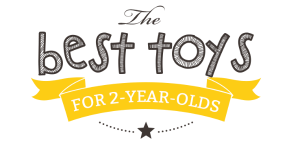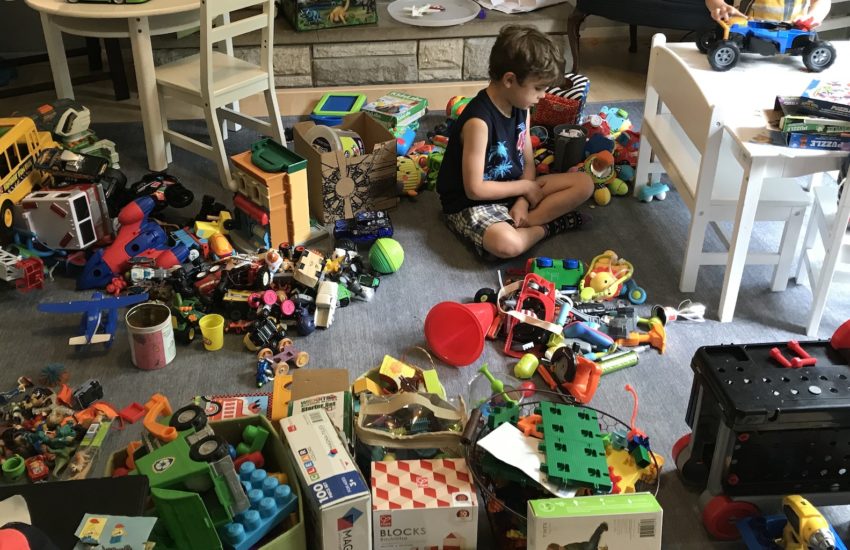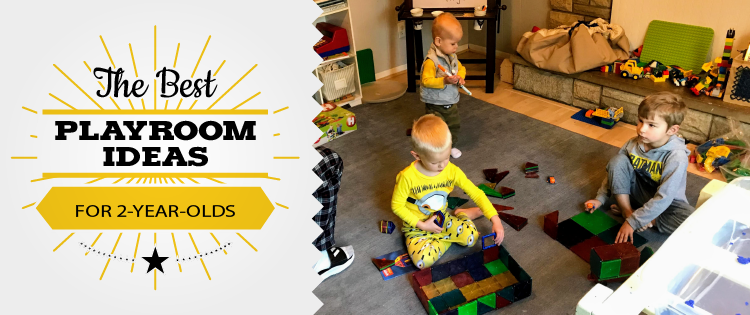Last Updated on March 9, 2023 by admin
Shown: My former-2-year-old in his playroom as I attempt (once again) to organize all his toys
Toys for toddlers, perhaps more than toys for any other age group, tend to take up more space command more attention with their “life-sized” furniture, sing-songy buttons and bright colors.
It all gets overwhelming quickly, especially if you’re one of the families with lots of well-meaning relatives who give toys regularly.
It’s possible that the always-perfectly-organized, Instagram-worthy playroom is a little bit of a pipe dream. (Even organization expert Marie Kondo recently admitted that her house isn’t tidy now that she has three kids.) But I do think it’s possible to at least have a space in your home that’s relatively easy to de-clutter when you do have the time to do it.
There are four main steps to organizing a beautiful playroom for a toddler:
- Step 1: Settle on a style or aesthetic for the room
- Step 2: Organize all the toys in your house into groups and pare them down if possible
- Step 3: Decide which of those toy groups will “live” in the playroom
- Step 4: Choose a storage system and play area for each playroom toy group (in line with the aesthetic you picked)
As an Amazon affiliate, I earn from qualifying commissions.
Step 1: Settle on a design aesthetic for the playroom.
Technically aesthetics and the organization are two separate issues. But it can help at the beginning of this process to visualize what you want your playroom to look and feel like. This can help you in later steps as you choose what types of toys you want in the room and the storage and play areas for those toys. The most popular playroom design types generally fall into one of these categories:
- bright/bold (lots of primary colors and a fun exciting feeling)
- naturalistic (lots of natural colors and materials, such as wood instead of plastic, to evoke a sense of serenity)
- cozy (this style uses soft textures and lines and warm colors to create a space that feels safe and and inviting)
- minimalist (lots of white space, clean lines, and very few toys on display)
- whimsical (feminine touches, muted colors, and a space that feels magical)
For more ideas, check out my full post on playroom styles for toddlers. Of course, you don’t have to choose any of these styles and can just wing it. (We don’t all have time to play interior designer when we’re raising tiny humans.)
Step 2: Organize all the toys in your house into groups.
If your goal is a pleasant, organized playroom, tossing all the toys into the room and calling it a day isn’t going to work. To start, you should physically compile your kids’ toys into groups (stuffies, small vehicles, large vehicles, etc.) and pare down if necessary. For example, does your kid need the 10 medium sized dump truck toys you rounded up? Maybe he does! Either way, now is the time to make that decision.
Step 3: Decide which toy groups will “live” in the playroom (and in other areas of the house).
Again, this post is about organizing the playroom, not the whole house. But in order to organize the playroom, you need to know which toys will stay OUT of that room.
To figure that out, you have to decide what kind of play you expect to happen in each area (and plan to keep some areas of the home toy-free so you can go to those spaces to relax).
Here are a the most common options for indoor toddler play.
- Large motor play: “Large motor” is just a fancy way of saying “play with the whole body,” such as running, jumping, and climbing. This is probably toddlers’ favorite type of play, but it’s generally only suitable for playrooms that have a little bit of space and that don’t also have breakable things (lamps, TVs) and sharp edges (fireplace mantels.)
- Small/fine motor play: For the purposes of playroom design, fine motor play generally translates to “toys with a bunch of pieces,” such as blocks and miniature sets. These toys benefit from a designated play area because otherwise the pieces get spread throughout the playroom and the entire home.
- Art play: This is where your kids will get messy with age-appropriate supplies to make colorful creations.
- Sensory/tactile play: 2-year-olds love to squish mud and play dough and work with other fun-to-feel substances such as sand or rice. You might want to include a place in the playroom for this to happen, such as with a dedicated sensory table or bin.
- Reading / quiet time: Some people want to include a quiet little nook in the playroom to encourage kids to look at their picture books or just get some time to themselves when they’re upset.
- Imaginary play: Sure, imaginary play can happen anywhere, but at some point you need to choose whether you want to store things like play kitchen, play baby doll furniture, play cleaning supplies, etc. in the playroom or elsewhere. (For example, some people want to store a play kitchen near the real kitchen instead of in the playroom.)
You certainly don’t need to have a space for every one of these popular indoor play “types” in the playroom. For example, my kids’ large motor area is the basement if I can’t get them outside, and their sensory play and art play happens in the kitchen, where it’s easier to monitor and clean. Because my playroom is small and relatively out of the way, I use it mostly for the fine motor play (also known as the toys-with-many-pieces).
Step 4: Choose the storage/display methods for each type of play.
Each play type you’ve chosen to add to the playroom needs two things: an area to store the toys/supplies, and an area for the kids to use the toys/supplies. These areas can overlap for different toy types, of course. For example, many playrooms just have one small open area for toys. But it helps to think through each play type so you have space for everything.
In general, you’ll want to store the toys/supplies near where you expect your kids to play with or use them. Here are some ideas for each type of play.
Large Motor Area
Toy examples: Nugget couch (ideal for lifting and crashing down), an indoor wall gym, a crash pad, mini-trampoline, sit-and-spin
Use area: Open space
Storage area: These toys are generally self contained, even if they do take up more space than other types of toys. I think the reason the Nugget couch and their lookalikes are so popular is that they double as a seat, such as for a reading area.

Small Parts Toys Area
Toy examples: Blocks, miniatures sets, wooden train sets, small vehicle sets, puzzles, and things like shape sorters and stackers, and even board games.
Use area: You can just let the kids play with these toys on the floor, which they’re usually perfectly happy to do, or you can invest in a train table that has an edge designed to help contain pieces. Full post: How to choose a train table. Of course, most of these toys also work on a regular table without an edge, which can double as an art table (see next section).
Storage area: Some train tables come with built-in storage. Otherwise, you can invest in Swoop bags for things like Duplos and HotWheels, or use some type of bin system. I don’t generally like bins for storage because 2-year-olds love to dump them out for fun, but a few bins may be necessary for these types of toys. You may want to invest in a bin system that tilts the bins toward you so it’s easy for kids to see their contents. If you choose another shelving system, make sure there’s no tip risk.


Art Play Area
Toy examples: Finger paint, dot markers, sidewalk chalk
Use area: An activity table or an easel (You don’t need a full-height easel to get the job done; some easels are designed to sit on the table or floor. See the full post on art supplies for 2-year-olds for more easel suggestions). An activity table can eventually double as an imaginary table for playing restaurant, and can also be an ideal place for board games or other sit-and-concentrate activities, such as shape sorters and puzzles.
Storage area: Some activity tables and easels come with built-in storage, or you can store the art supplies in an art cart or in a bin that’s out of reach until they need it.


Sensory Play Area
Toy examples: Play dough, play sand, sensory bins full of rice or other substrate
Use area: Sensory play can happen in a simple bin on the floor, on an activity table or train table, or in a designated sensory table designed to hold the bin.
Storage area: The sensory tools should be placed in a bin nearby but out of reach. You might choose to incorporate a little hook for hanging up art smocks or water smocks if you’re into that.
Calming Area or Reading Area
Toy examples: Books or other quiet-time activities
Use area: A bean bag, a little tent, a play couch, a sensory swing that acts as a little cocoon
Storage area: A bookshelf or just an area to keep a small stack of books or a bin for calming objects

Stuffed Animal and Doll Area
Use area: These little guys tend to get used throughout the house, but if you want them to stay in the playroom, just make sure there’s plenty of open space for them to hang out.
Storage area: In particular, dolls might benefit from a designated area for things like a crib and stroller, and a bin for their accessories. Stuffies can be stored in a bean bag, or a net “hammock” if you have a lot of them. (Personally, I keep all my kids’ stuffies up in their bedroom in an under-bed container.)
Tying it All Together
As I wrote in my post on organizing toddler toys, the only way the playroom will stay even relatively tidy is if you make a few general rules about toy use, such as “only five stuffed animals out at a time” or “only one vehicle set at a time.” (These rules are just as much for adults as they are for the kids, since adults generally control which toys are accessible.)
With that in mind, let’s sum up the different options you have for designated play areas and toy storage in the playroom.
Play/Activity Area Options:
- a rug or multiple area rugs
- a small activity table
- a larger train table
- A teepee, tent, or tent swing
- a soft surface on which to snuggle and/or throw themselves down /roll around without a care
- pretend play stations such as a playhouse, play kitchen, work bench, pop up food truck, etc.
Toy Storage Options:
- an accessible shelf that the kids can reach that you can use to rotate different toys, books, and activities
- Swoop bags (or similar)
- storage inside play furniture such as easels, tables, play kitchens, etc.
- Freestanding bins or baskets
- A bookshelf (one that’s specifically for books)
- Inaccessible shelves (out of reach and out of sight so kids don’t try to climb)
- A traditional toybox (I don’t advise these because they’re generally heavy and toys tend to get lost at the bottom)
Of course, as your kids get older, your playroom will continue to change and evolve with their interests. Good luck creating an indoor play space that feels inviting and keeps the toys a little more contained from the rest of the house.











